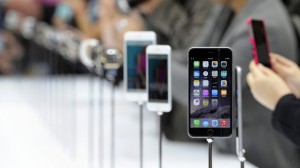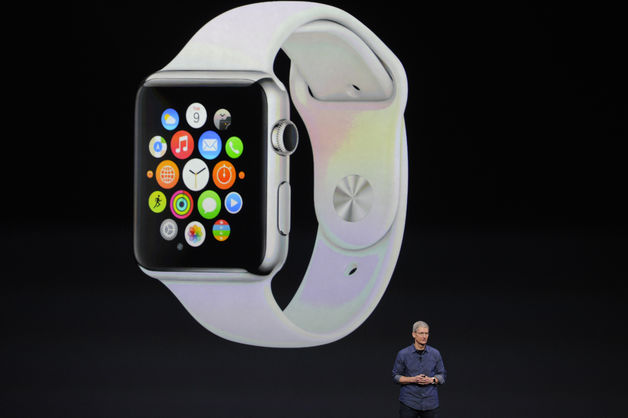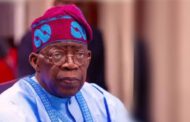Apple Inc. (AAPL) unveiled a fresh ecosystem of products and services — with a smartwatch, mobile-payments system, health applications and bigger-screen iPhones that all work together — in the biggest new lineup so far under Chief Executive Officer Tim Cook.
The company today took the wraps off Apple Watch, a line of watches with a rectangular face and rounded edges, with wristbands that can be swapped out. The device, which will start at $349 and be available early next year, is Apple’s first new product category since the Cupertino, California-based company introduced the iPad in 2010.
Apple debuted the watch at an event near its headquarters in Cupertino, along with Apple Pay, which is designed to make the watch and iPhones into a digital wallet, and the new iPhone 6 and iPhone 6 Plus, which have screen sizes of 4.7 inches and 5.5 inches. The company also showed health apps that work on the new watch and iPhones, underlining how dependent the services are on Apple’s devices and vice versa.

Iphone 6
Apple’s stock fell following the conclusion of the event, with shares declining less than 1 percent to $97.99 at the close in New York. The shares have typically fallen at other events where it debuted new products. On Sept. 10, 2013, the day Apple introduced the iPhone 5s and 5c, the stock declined 2.3 percent.
Photographer: David Paul Morris/Bloomberg
The new Apple Inc. iPhone 6 is displayed after a product announcement at Flint Center… Read More
Cook’s Apple
The announcements are Apple’s most wide-ranging set of product introductions under Cook, who succeeded co-founder Steve Jobs in 2011. For the past three years, the company had made mostly incremental changes to existing products, raising questions of whether it could build another hit product. With today’s lineup, the company is responding by leaping into new areas of the fiercely competitive consumer-technology industry.
“We have some amazing products to show you,” Cook said as he began the presentation. “We think at the end of the day that you will agree that this too is a very key day for Apple.”
Apple is already coming into this year’s product unveiling in a different position than in 2013. Last September, the company’s stock was slumping and it was losing market share to Samsung Electronics Co. and low-cost manufacturers such as Xiaomi Corp. Questions abounded about whether Apple could keep innovating without Jobs, who died in 2011.
Now Apple’s stock has rebounded, rising more than 20 percent so far this year and flirting with a record high, even with shares declining today. Not even a recent incident involving leaked pictures of naked celebrities whose Apple iCloud accounts were hacked could derail investor enthusiasm.
Photographer: David Paul Morris/Bloomberg
Tim Cook, chief executive officer of Apple Inc., unveils the Apple Watch during a… Read More
Apple Watch
Apple Watch, which was met with a standing ovation by the crowd at the event, has newly designed software that works with a dial on its side. The touch-screen device comes in two sizes, as well as in classic, sports and gold edition models.
It can be used to detect pulse rate and has other health-tracking apps, such as letting a user monitor calories burned along with how long he or she has been seated. Goals can be set and milestones rewarded as well. The watch also includes apps for maps, photos, music and messages, the company said.
When the watch becomes available next year, it will only be on offer in the U.S., Apple said. An iPhone is required for Apple Watch to work.
“Apple Watch is the most personal device we have ever created,” Cook said at the event. “We set out to create the best watch in the world.”
Apple Pay
Cook unveiled the watch after earlier introducing Apple Pay, the mobile payments system, which will work with the new timepieces and iPhones. Apple is partnering with credit-card companies including American Express Co. (AXP), MasterCard Inc. and Visa Inc. for the service, which will be offered in the U.S. starting next month. Retailers that will support Apple Pay include Staples Inc. and Whole Foods Market Inc., the company said.
In starting a mobile-transaction service, Apple squarely took aim at existing payments services.
“Our vision is to replace this and we’re going to start by focusing on payments,” Cook said as a picture of an old wallet was flashed on screen.
The image of a leather billfold also appeared on the company’s website with a message saying, “Wallet, your days are numbered.”
Apple Pay will work with services including mobile car-booking application Uber Technologies Inc., restaurant reservation system OpenTable and daily deals company Groupon Inc., the company said.
Bigger Phones
The new iPhones, meanwhile, will have rounded edges and a thinner frame than earlier models, as well as higher-resolution displays. The iPhone 6 costs $199 to $399 with a two-year contract, while the 6 Plus is priced at $299 to $499. The devices will come in silver, gold and space gray.
The handsets will initially be available in a limited set of countries — including the U.S., Australia, Canada, France, Germany, Hong Kong, Japan, Puerto Rico, Singapore and the U.K. – – for pre-order on Sept. 12 and shipping on Sept. 19, the company said.
The new iPhones come with a custom A8 64-bit processor, which Apple said is 25 percent faster than the chips in previous models. The phones have a new motion processor for fitness and health-related applications. Apple said more than 200 carriers support the new handsets.
The iPhone remains the most important piece of its business. The handset accounted for about half of Apple’s $171 billion in revenue last year, and with sales of the iPad slowing down, the company needs to keep the iPhone a blockbuster in order to maintain growth.
Big Screens
Apple is betting the success of the iPhone will aid the other products introduced today. While the new handsets are widely anticipated to be huge hits, the watch, payments system and health software are no sure thing.
Companies such as Samsung have also introduced so-called smartwatches that have smartphone-like functions for checking messages and getting notifications. None have gained widespread traction and the products have seemed more like technology in search of a problem rather than solving a real need. Similarly, technology that turns a smartphone in a wallet also hasn’t become popular, even with efforts by Google Inc. and EBay Inc. Fitness-tracking devices like Fitbit also have remained a niche.
According to Parks Associates, 2.8 million so-called smartwatches were sold last year, along with another 13.6 million fitness tracking devices. By comparison, 1 billion smartphones were shipped last year, according to IDC.
“If you believe in having a screen on your wrist, then this is the way to do it, but the question is whether this is something people want,” Benedict Evans. a partner at venture capital firm Andreessen Horowitz. said in an interview about the Apple Watch. Bloomberg LP is an investor in Andreessen Horowitz.
Flint Center
In a nod to how important today’s product lineup is to Apple, the company held the event at the Flint Center for the Performing Arts near its headquarters in Cupertino. It was the same venue where it introduced the Macintosh 30 years ago and where Jobs revealed the iMac in 1998, spurring Apple’s trajectory from near bankruptcy to the world’s most valuable company.
The event was filled with the usual theater of Apple occasions, with celebrities and moguls in attendance. Media from around the world also packed the more than 2,000-capacity theater. News outlets from fashion and lifestyle publications sat alongside business and technology press.
The new products have been anticipated for months and company executives have stoked expectations in the past year. In May, Eddy Cue, head of iTunes, said products to be introduced later this year are the the best pipeline Apple has had in 25 years. In July, Chief Financial Officer Luca Maestri echoed that by saying he was “expecting a very busy fall.” Cook chimed in and said the company has an “incredible pipeline” that “we can’t wait to show you.”













